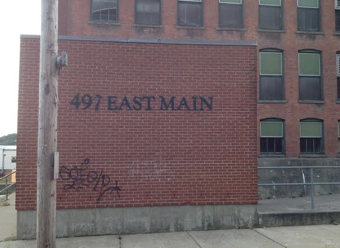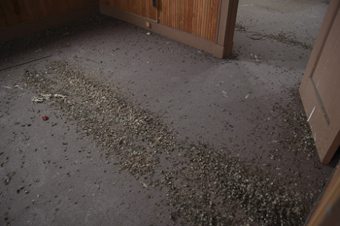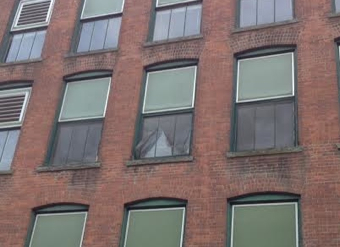 Broken windows. Boarded up windows. “Vermin infestation.” Graffiti. “Accumulations of feces.”
Broken windows. Boarded up windows. “Vermin infestation.” Graffiti. “Accumulations of feces.”
Those items are on a list of “blight conditions” for which the City of Ansonia can cite a property owner and threaten them with fines upwards of $100 per day.
But they’re also conditions which apply to two properties the city itself owns on Main Street in the heart of the downtown Ansonia.
So will the city be hauling itself to the hoosegow sometime soon?
Don’t count on it.
Blight Background
Ansonia Aldermen passed an “anti-blight” ordinance in April, part of which allows the city to hire contractors to clean badly blighted properties after giving property owners fair warning and a chance to clean up the mess themselves.
The city has performed more than a dozen such cleanups using its “Clean and Lien” prgram.
Click here for more background from a previous story.
In a PowerPoint presentation handed out at Board of Aldermen meeting Monday (Aug. 11), city officials said the reasons for cracking down on blight are obvious.
“Why Be Concerned?” about blight, asks the title of one of the presentation’s slides.
It answers:
- Blight creates health, safety and fire hazards for property owners and neighbors.
- Blight lowers property values.
- Blight discourages community visitors, investors, shoppers, and potential home buyers.
- Blight interferes with neighbors’ rights to enjoy their properties.
- Blight poses a safety risk to police, fire, and rescue services.
Mayor David Cassetti touted the success of the city’s “new, aggressive blight program, which is cleaning both residential and commercial properties in our city, making Ansonia more attractive for investment.”
 Cities In Glass Houses …
Cities In Glass Houses …
By the city’s own standards, two properties the city itself owns — the “Ansonia Technology Park” building at 497 E. Main St., and the adjoining Palmer Building at 153 Main St. — satisfy several of the conditions enumerated in Ansonia’s anti-blight ordinance.
For instance, several of the windows of 153 Main St. were either broken or boarded up with “unpainted wood” on the afternoon of Aug. 12.
Piles of pigeon droppings litter the interior of the building.
A graffiti artist’s handiwork was displayed around the corner, on a brick wall immediately under lettering showing the address of the Technology Park building.
(Click here to check out a shot from the Connecticut Post’s Brian A. Pounds of Alfred E. Neuman reborn in white spraypaint on a United Illuminating box in front of 497 East Main St. July 28.)
On the building itself, a window’s screen was torn.
Paint on both structures is faded.
Any one of those conditions can result in a property owner receiving a blight citation under the ordinance passed by the city this year.
The apparent double standard is pointed out by Valley Indy readers every time a blight-related article is published.
Valley Indy reader Sandy Shrti commented on the “double standard” about 90 minutes after a Valley Indy story about the city’s “Clean and Lien” program was posted Aug. 5.

“It’s a different situation entirely,” said Ansonia Corporation Counsel John Marini, Cassetti’s point man on the blight battle, when asked about the city’s Main Street properties.
“The city is not a landlord,” Marini said. “The intention was never for the city to hold these properties and to operate them as a business owner or an investor. The city is only holding these buildings as a last resort. We want them in the hands of investors, we want them in productive use.”
He said the city is doing the best it can with “limited resources” — its Department of Public Works — to maintain upkeep at the two blighted properties.
“We’re trying to do the absolute best with the resources we have to clean those buildings, to not keep them in blight, but remember, every effort’s being made to sell those buildings,” he said. “If we were maintaining City Hall like that, there would obviously be a serious issue, but the city, with limited resources, has to maintain many properties.”
Marini said the city has put “thousands and thousands” of dollars into things like asbestos remediation at the properties.
He pointed out Cassetti’s administration has only been handling them since December 2013. The properties have been on the mind of administration officials since at least February.
“Still,” he conceded, “the conditions you describe are unacceptable and are in the process of being remediated. But those conditions don’t appear overnight. We’ve had nine months with these buildings.”
According to city land records online, the city bought the Palmer Building for $195,000 in 1994. The Ansonia Technology Park building was acquired by the Ansonia Redevelopment Agency in 1984 for $154,000.
“Where those buildings are now from where they first were when the city took them over, there’s a substantial remediation that has been done,” he said. “And they are safe, there’s no question about that.”
Marini said it would be unfair to say the city neglected the buildings in the same way as, for instance, Farrel Corp. did with its “process lab,” the massive, white building adjoining them to the north with enough broken windows to send a trypophobe running for the hills.
The city hopes to more aggressively pursue a sale of the properties under the stewardship of Economic Development Director Sheila O’Malley, Marini said.
Criminal Penalties?
During Monday’s meeting Aldermen voted to enhance the city’s anti-blight ordinance with the addition of what Marini called a “criminal penalty” for property owners who willfully violate the city’s blight rules.
The criminal penalty amendment gives the city the ability, pursuant to a state law, to levy fines of up to $250 per day against owners of blighted residential properties who willfully violate the blight regulations, provided they have 10 days to fix any issues and that the city inspects the property every day it fines the landlord.
The law already called for fines of $100 a day and, after 30 days, $250 per day.
So what’s new?
Marini told the Aldermen the revised ordinance “gives us another arrow in the quiver” of combating blight.
Article continues after video of Marini talking to Aldermen Aug. 11.
After the meeting, he said the new law puts “jail on the table” for property owners who willfully disregard a court order concerning blight.
“Once they’re thrown into the criminal court system, if they’re given the penalty and they’re not compliant with the penalty, the state’s attorney has the ability to take the case even further, because now they’re not compliant with an order of the court,” he said. “That’s very different from a fine that the city can give that’s just accumulating as a lien.”
“Delivering a summons to the violator, having them appear in court, having a court order entered against them, and of course now they’re in a position where if they don’t comply with the court order they’re in contempt, that’s a lot more stringent with simply getting a civil fine,” he added.
Another addition calls for blight fines to be forgiven if a property owner cleans a property up within 10 days of being cited.
Since only eight Aldermen attended Monday’s special meeting, the city will have to hold a public hearing on the amended ordinance before it takes effect.